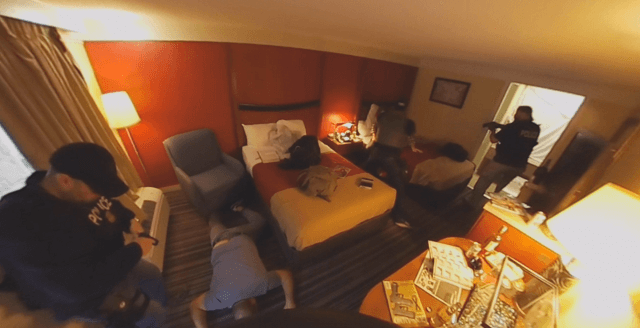By Leischen Stelter, editor of In Public Safety
As the training begins, officers enter a suspected drug house. One officer looks left, the other looks right as they clear the room. Two suspects are detained, one is wearing an Islamic head covering and the other is a white male with a shaved head. Objects litter the room including drug paraphernalia and a Quran. Is this a drug house or is there reason to suspect terrorist activity?
At first, such a scenario may sound like a fairly common training exercise for police, until you realize how it’s being delivered. Officers participating in this training are all wearing 360-degree virtual reality headsets. This technology allows them to train together—they’re all seeing the exact same video—but the headsets allow them to each have complete control over their own perspective. For example, as one officer looks left, another can look right, while another can look up, down, or behind him.
Try it out: Click the video below and drag your mouse around to see an example of a DIRT training video in action. (You must use Chrome, Firefox or the latest version of the YouTube app to view the video correctly.)
Referring to this training as virtual reality isn’t completely accurate because it’s much more than just a realistic video game. “It’s digital immersion, not virtual reality. We’re using virtual reality technology, but we’ve created a much more innovative training program than what exists out there,” said Darren Heater, who is the owner and lead creative director for DMH Visual Productions. Heater partnered with American Military University and organizers of INLETS, an FBI-led series of training seminars, to produce an innovative training program for law enforcement.
The training is called DIRT, Digital Immersion Reality Training, and the objective is for officers to experience a realistic training scenario as a team while allowing individual officers to develop their own responses and reactions about the investigation.
This training represents the future of law enforcement training. “This is the way young officers want to learn. They want immersive technology and they want it to be realistic, but they don’t want to play a video game,” said Tim Hardiman with American Military University. “DIRT gets the adrenaline flowing and it mimics the reality of scenarios as much as possible.”
Creating a Realistic Scenario Using Virtual Reality
Authenticity was the number one priority for creating DIRT. “My background in filmmaking means I’m always trying to create an authentic narrative that is real and not cheesy fake,” said Heater, who has worked in video production for 15 years. “Officers are really going through a law enforcement situation where they feel like they can learn and experience the scenario.” To add to the authenticity, Heater used real police officers as “actors” so everything about the training is realistic and accurate.
Since he doesn’t have a law enforcement background, the INLETS program enlisted the help of subject matter experts to help embed the script with the latest training principles. Brig Barker, who spent 20 years as a counterterrorism agent with the FBI, is considered an expert on the jihadist mindset and identifying signs of terrorist activity. Using scenarios from real cases and interviews with hundreds of jihadists, Barker co-wrote the narrative script with Heater for the first DIRT training, The Path to Radicalization.
“When I was writing the screenplay, I wanted to make it challenging for all levels of law enforcement,” Barker said. “Everything is not as it appears. I built in some micro-nuances to make everyone think.”
Barker retired from the FBI in 2016 and started Red Rock GSG, a company that develops tools to help law enforcement disrupt terrorist attacks. The innovativeness of DIRT is what drew him to the project. “The more interactive and realistic the training, the better,” he said. “It gives officers the opportunity to make mistakes and practice this strategy in a realistic situation.”
What’s Next for DIRT?
The Path to Radicalization training will launch at the INLETS seminar on June 19-23 in Annapolis, Maryland. Attendees will have the opportunity to go through the digital immersion training with Barker serving as a facilitator. As attendees move through the five levels of the scenario, Barker will share learning points and lead a discussion about the details of the investigation and what items are potential indicators of radicalization.
The INLETS seminar is a great setting to launch this training because attendees represent all levels of law enforcement. DIRT was beta-tested at the April Gulf Coast INLETS seminar in New Orleans and the response was overwhelmingly positive, said Heater. “Nearly every attendee at the conference tried it and we got some really good feedback about how to make it even better for the official launch,” he said.
The INLETS launch is the first phase of the DIRT program. In addition to offering in-person training using virtual reality technology with a facilitator, DIRT will also be offered in an online format so officers can experience the scenario on their own schedules. Finally, they are also offering custom-made DIRT programs where organizations can engage the DIRT team in designing and producing exact scenarios that fit their training needs. If you are interested in learning more about this training and want to be notified when new trainings are released, send an email to Rob Stallworth at RStallworth@apus.edu.

Comments are closed.